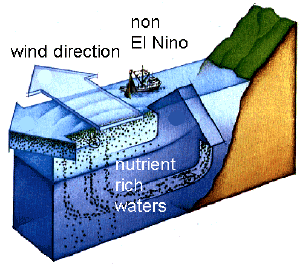 Although
details of El Nino events can be traced in the written literature back
to 1726 using different ship captains' logs, it probably was in
existence before that time. The latest and one of the strongest and
longest El Nino on record, began in early 1982 and continued until late
summer of 1983, and caused disastrous results throughout the world.
Scientists blamed droughts in Australia, Indonesia, Peru, and Hawaii.
Storms and flooding in California, south Pacific, Gulf States, Cuba, and
Ecuador as well as destruction of Pacific coral reefs and changes in the
fish population off of Peru to California were blamed on El Nino. Although
details of El Nino events can be traced in the written literature back
to 1726 using different ship captains' logs, it probably was in
existence before that time. The latest and one of the strongest and
longest El Nino on record, began in early 1982 and continued until late
summer of 1983, and caused disastrous results throughout the world.
Scientists blamed droughts in Australia, Indonesia, Peru, and Hawaii.
Storms and flooding in California, south Pacific, Gulf States, Cuba, and
Ecuador as well as destruction of Pacific coral reefs and changes in the
fish population off of Peru to California were blamed on El Nino.
When El Nino is not active, nutrients are brought
upwards from the ocean currents. This provides the nourishment for
plankton and serve as the basis of the food chain which drives the
Peruvian fishery. As the trade winds relax during an El Nino, fewer
nutrients are brought from depth and the productivity of the region is
diminished. During the most severe El Ninos, the productivity may be so
low that the fishery collapses. Beaches along the effected area have
dead sea lions, bivalves, shrimp-like creatures, and a variety of birds
like cormorants and boobies. The tide pools are also effected because
many invertebrate faunas that lived among the rocks disappeared. But how
could a warming of a current cause such an effect?
|